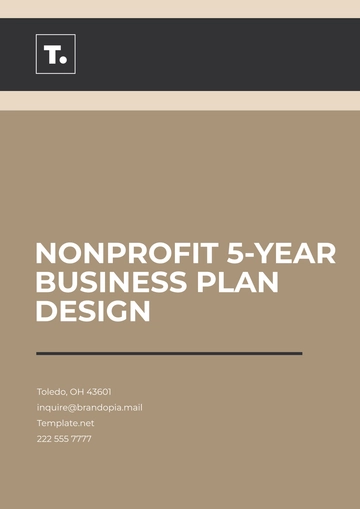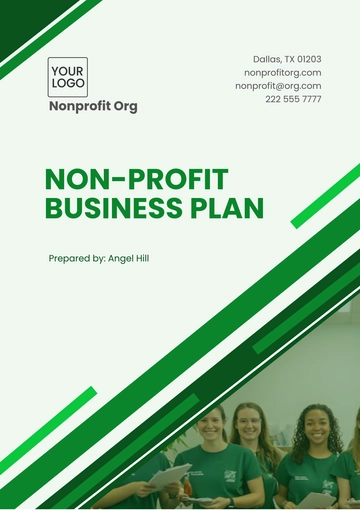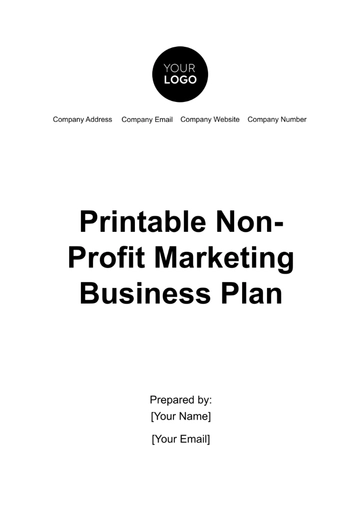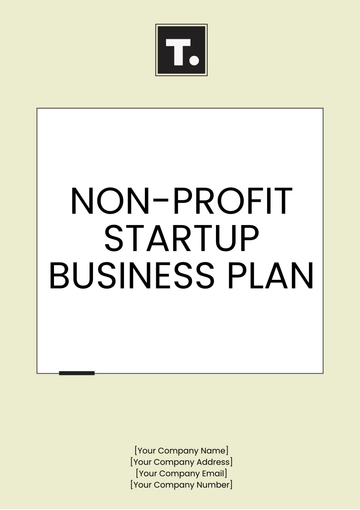Free Printable Non-Profit Marketing Business Plan
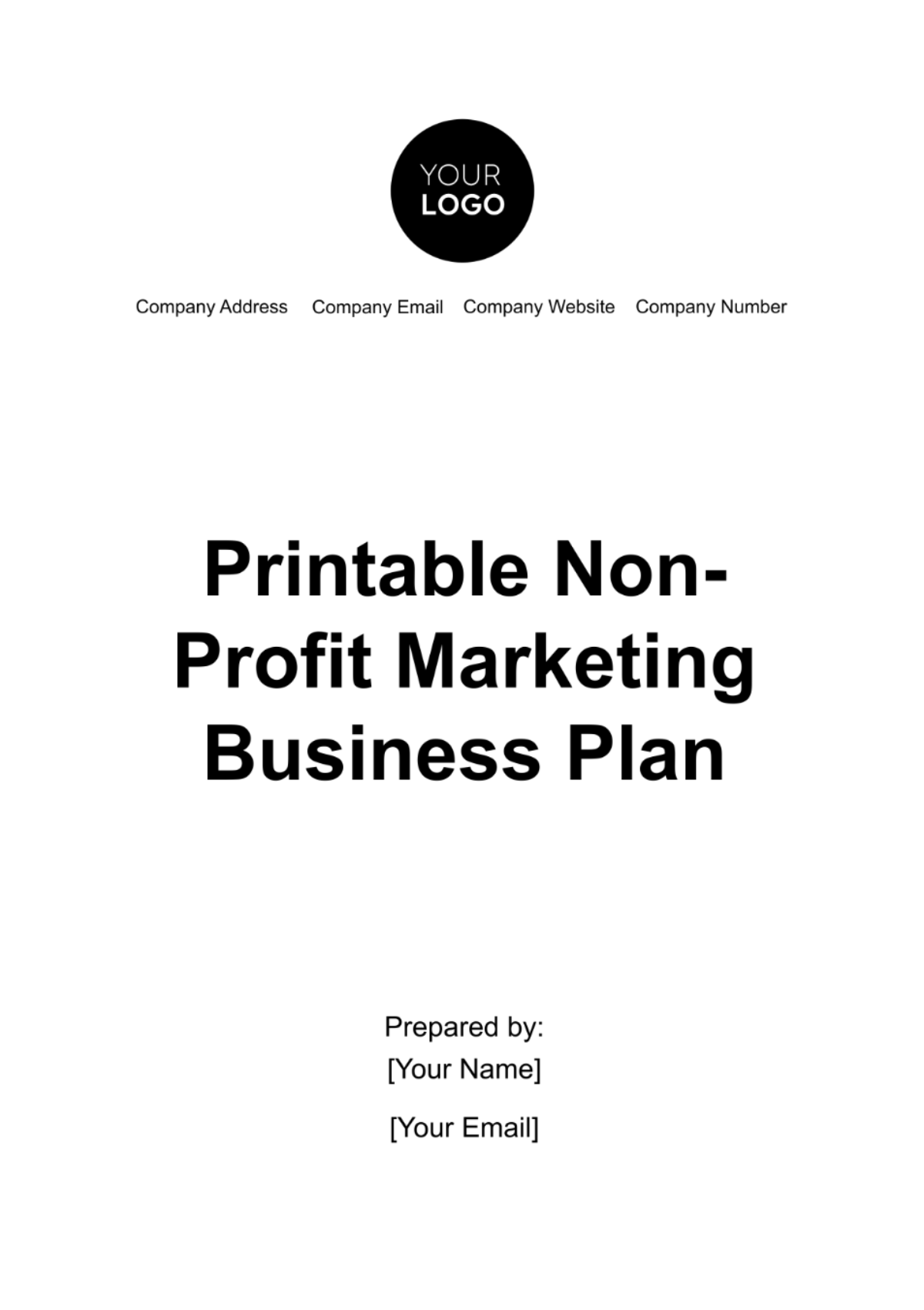
I. Executive Summary
A. Overview of the Non-Profit Organization
The [Your Company Name] is a leading advocate for environmental preservation, focusing on sustainable practices and community engagement. Established in 2010, our organization has spearheaded numerous initiatives aimed at reducing environmental impact and educating the public. Our commitment to fostering a greener future drives all our activities and outreach efforts.
B. Mission Statement
“To inspire and empower communities to create a sustainable future by fostering environmental stewardship and sustainable practices.” This mission guides every program and campaign, ensuring that our efforts align with our core values and objectives. We strive to make a measurable difference in environmental conservation through innovative solutions and community partnerships.
C. Summary of Marketing Objectives
Our primary marketing objectives are to enhance public awareness about environmental issues and increase engagement with our programs. We aim to boost community involvement and achieve a [00]% increase in donations over the next year. By reaching these goals, we seek to expand our impact and support for sustainable initiatives.
D. Key Strategies and Tactics
Our strategy involves leveraging digital marketing channels, including social media and email campaigns, to reach a broader audience. We will also engage in strategic partnerships and local events to build stronger community connections. Additionally, we will implement a content-driven approach to highlight our successes and educate the public on sustainability.
E. Expected Outcomes and Impact
We anticipate a [00]% increase in social media engagement, leading to greater visibility for our programs and mission. Our goal is to see a [00]% rise in event participation and significantly higher donor contributions, which will facilitate the expansion of our initiatives. These outcomes will enhance our ability to drive environmental change and support our core objectives.
II. Organizational Background
A. History and Background of the Non-Profit
Since its inception in [Year], the [Your Company Name] has grown from a grassroots effort into a prominent player in environmental advocacy. We began with small-scale local projects and have expanded to a range of impactful programs that address global environmental challenges. Our growth reflects our dedication to creating a sustainable future through innovative and community-focused approaches.
B. Mission, Vision, and Values
Our mission is to inspire and empower communities to embrace sustainability through education and action. We envision a future where environmental stewardship is a fundamental aspect of everyday life. Our core values of sustainability, education, community, and integrity drive all our initiatives and interactions with stakeholders.
C. Programs and Services Offered
We offer a variety of programs, including educational workshops for schools, community clean-up events, and tree planting initiatives. Our “Green Schools” program integrates environmental education into school curricula, fostering awareness from a young age. These programs are designed to engage different segments of the community and promote sustainable practices.
D. Key Achievements and Milestones
We have successfully planted over 10,000 trees in urban areas, significantly enhancing local green spaces. Our “Green Schools” program has reached over 50,000 students, integrating sustainability into their education. In [Year], we were honored with the “Best Environmental Initiative” award by the City Council, recognizing our significant impact.
III. Market Analysis
A. Target Audience
Our target audience includes environmentally conscious adults aged 25-45, families with children, and educators interested in sustainability. This demographic is motivated by a desire to contribute to environmental preservation and is active in community engagement. Understanding their needs and preferences helps tailor our marketing efforts to effectively reach and engage them.
B. Market Trends and Insights
There is a growing trend toward sustainability and climate action, with increasing public demand for actionable solutions. Digital platforms are pivotal in shaping public opinion and facilitating engagement with environmental causes. This trend presents an opportunity for us to expand our digital presence and connect with a wider audience.
C. Competitive Analysis
Organizations such as Earth Save and Green Tomorrow also focus on environmental conservation but differ in their approaches. Our unique selling propositions include our emphasis on local community involvement and hands-on projects. By highlighting these differentiators, we can effectively position ourselves in the competitive landscape.
D. SWOT Analysis
Our strengths include a strong community presence and effective educational programs, which build trust and engagement. However, we face challenges such as limited national visibility and reliance on local funding. Opportunities lie in expanding digital outreach and forming national partnerships, while threats include economic downturns and competition from larger organizations.
IV. Marketing Goals and Objectives
A. Long-Term Goals
Our long-term goal is to establish the [Your Company Name] as a leading national advocate for environmental sustainability. We aim to build a broad network of supporters and partners who share our vision of a sustainable future. This will involve expanding our reach and influence across various regions and sectors.
B. Short-Term Objectives
Over the next six months, we aim to increase our social media engagement by [00]% and grow our email subscriber list by [00]%. Additionally, we plan to raise $[00] through targeted fundraising campaigns within the year. These objectives are designed to build momentum and support for our long-term goals.
C. Key Performance Indicators (KPIs)
KPIs will include metrics such as social media engagement rates, email open and click-through rates, and total funds raised. Tracking these indicators will allow us to measure the effectiveness of our marketing strategies and make data-driven decisions. Regular reviews of these KPIs will help ensure we stay on track to meet our objectives.
D. Alignment with Organizational Mission
All marketing activities will be aligned with our mission to promote sustainability and environmental stewardship. This alignment ensures that our efforts are focused on achieving our core objectives and making a meaningful impact. By integrating our mission into every campaign, we reinforce our commitment to our values and goals.
V. Marketing Strategies
A. Branding and Positioning
We will develop a cohesive brand identity that highlights our commitment to local impact and sustainability. Our messaging framework will emphasize the unique aspects of our programs and the tangible benefits of supporting our mission. This approach will help us effectively position ourselves in the market and resonate with our target audience.
B. Audience Engagement
Engaging with the community through events and educational initiatives will be a key focus of our strategy. We will implement programs to actively involve volunteers and donors, recognizing their contributions and fostering deeper connections. This engagement will build a loyal supporter base and enhance our community presence.
C. Content Strategy
Our content strategy will include a mix of informative blog posts, engaging videos, and visually appealing infographics. We will distribute this content through our website, social media channels, and email newsletters to maximize reach and impact. By providing valuable information and showcasing our successes, we aim to educate and inspire our audience.
D. Digital Marketing
We will run targeted social media campaigns to raise awareness and drive engagement with our programs. Our email marketing efforts will focus on keeping our supporters informed and involved through regular updates and calls to action. Additionally, we will optimize our website for better user experience and search engine visibility to attract and retain visitors.
E. Traditional Marketing
Traditional marketing efforts will include distributing print materials such as flyers and brochures in high-traffic areas and local businesses. We will also participate in and sponsor community events to enhance our visibility and connect with potential supporters. These efforts will complement our digital strategies and reach audiences who prefer traditional media.
VI. Marketing Tactics and Action Plan
A. Detailed Action Steps
We will initiate a social media campaign featuring weekly environmental tips and success stories from our programs to engage our audience. Our team will organize quarterly community clean-up events and sustainability workshops, ensuring each event is well-publicized and attracts diverse participants. Additionally, we will develop and distribute a monthly email newsletter that highlights program achievements, upcoming events, and donor contributions.
B. Timeline and Milestones
Month 1 | Complete a brand refresh and launch a redesigned website with enhanced features for user engagement. |
Month 2-3 | Roll out the social media campaign and initiate email marketing efforts to increase outreach and visibility. |
Month 4 | Host the first community event, evaluate the initial impact of our marketing efforts, and adjust strategies based on feedback and performance metrics. |
C. Responsibilities and Accountability
The marketing team will oversee social media management, content creation, and campaign execution, ensuring that all activities align with our strategic goals. The development team will focus on donor relations and fundraising campaigns, working closely with marketing to integrate messaging and outreach efforts. Volunteers will assist with event planning and on-the-ground support, contributing to the successful execution of community initiatives.
D. Collaboration and Partnerships
We will forge partnerships with local businesses to secure sponsorships and collaborative opportunities for events and campaigns. Collaborations with schools and educational institutions will enhance our “Green Schools” program and broaden our reach. Engaging with other non-profits and environmental organizations will help us share resources, expertise, and networks to amplify our impact.
VII. Budget and Resource Allocation
A. Marketing Budget Breakdown
Digital Advertising | Allocate $[00] for targeted social media ads, Google Ads, and online promotions to boost visibility and engagement. |
Content Creation | Invest $[00] in producing high-quality content, including professional videos, graphic design, and copywriting services. |
Events and Outreach | Set aside $[00] for organizing community events, workshops, and outreach activities, including venue rental and materials. |
Print Materials | Budget $[00] for designing and printing flyers, brochures, and posters to support traditional marketing efforts. |
B. Resource Requirements
Staff | A dedicated marketing coordinator to manage campaigns, a content creator for developing engaging materials, and an outreach specialist to build and maintain community relationships. |
Volunteers | Support from volunteers for event execution, social media management, and community engagement activities. |
Technology | Investment in website hosting, social media management tools, and email marketing software to facilitate and streamline marketing efforts. |
C. Cost Management and Efficiency
Regularly monitor and review expenditures to ensure that budget allocations are being used effectively and efficiently. Prioritize high-impact activities and seek in-kind donations and volunteer support to reduce costs. Implement cost-saving measures such as using free or low-cost digital tools and leveraging partnerships for event support.
D. Funding and Financial Support
Pursue additional funding through grant applications, corporate sponsorships, and individual donations to support marketing and operational needs. Develop a comprehensive funding strategy that includes both short-term and long-term goals to ensure financial sustainability. Regularly update stakeholders and potential donors on the impact of their contributions to encourage ongoing support.
VIII. Evaluation and Measurement
A. Metrics and Evaluation Criteria
Measure the success of our marketing efforts using KPIs such as social media engagement rates (likes, shares, comments), email open and click-through rates, and the total amount of funds raised. Track the growth of our supporter base, event participation, and website traffic to assess overall impact. Evaluate the effectiveness of each marketing tactic to ensure alignment with our strategic objectives.
B. Data Collection Methods
Utilize analytics tools for tracking social media performance, website traffic, and email campaign metrics. Collect feedback from event participants and donors through surveys and direct communication to gauge satisfaction and identify areas for improvement. Maintain accurate records of fundraising activities and donor interactions to monitor progress and effectiveness.
C. Reporting and Analysis
Prepare quarterly reports that summarize marketing performance, highlight key achievements, and identify areas for growth. Share these reports with internal stakeholders, including the board of directors, to keep them informed of progress and outcomes. Use insights from these reports to refine strategies and improve future marketing efforts.
D. Adjustments and Improvements
Based on evaluation results, make data-driven adjustments to marketing strategies and tactics to enhance effectiveness. Address any challenges or gaps identified through performance analysis and implement solutions to overcome them. Continuously seek feedback from supporters and stakeholders to ensure that marketing activities remain relevant and impactful.
IX. Appendices
A. Market Research Data
Include detailed market research reports, including surveys and focus group findings that provide insights into target audience preferences and behavior. Provide demographic and psychographic profiles of our audience to support strategic decision-making. Attach relevant industry reports that highlight trends and opportunities in environmental conservation.
B. Case Studies and Testimonials
Present case studies showcasing successful programs and initiatives that illustrate the positive impact of our work. Include testimonials from beneficiaries, volunteers, and donors that highlight their experiences and the value they derive from supporting our organization. These examples will help build credibility and demonstrate the effectiveness of our programs.
C. Sample Marketing Materials
Provide examples of marketing collateral, including flyers, brochures, social media posts, and email newsletters, to demonstrate our branding and messaging approach. Include samples of content used in previous campaigns to illustrate the style and tone of our communications. These materials will serve as references for evaluating and refining our marketing efforts.
D. Contact Information
List contact details for key personnel, including the marketing team, development staff, and organizational leadership. Provide information on how stakeholders and potential partners can get in touch with us for inquiries, collaboration opportunities, or support. Ensure that contact information is up-to-date and easily accessible.
- 100% Customizable, free editor
- Access 1 Million+ Templates, photo’s & graphics
- Download or share as a template
- Click and replace photos, graphics, text, backgrounds
- Resize, crop, AI write & more
- Access advanced editor
Enhance your non-profit marketing efforts with the Printable Non-Profit Marketing Business Plan Template from Template.net. This editable and customizable template is designed to streamline your planning process, offering a user-friendly AI Editor Tool for seamless adjustments. Tailor every section to fit your unique needs and elevate your marketing strategy effortlessly.
You may also like
- One Page Business Plan
- Coffee Shop Business Plan
- Restaurant Business Plan
- Food Business Plan
- Real Estate Business Plan
- Executive Summary Business Plan
- Cover Page Business Plan
- Nonprofit Business Plan
- Daycare Business Plan
- Construction Business Plan
- Startup Business Plan
- Medical Business Plan
- Bakery Business Plan
- Service Plan
- Hotel Business Plan
- Catering Business Plan
- School Business Plan
- Healthcare Business Plan
- Transportation Plan
- Sports Plan
- Car Wash Business Plan
- Salon Business Plan
- Clothing Business Plan
- Farming Business Plan
- Boutique Plan

